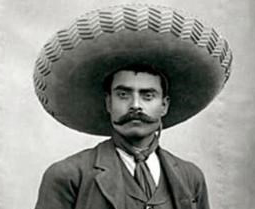Although I somewhat enjoyed the movie Viva Zapata, there were things about it that I just didn’t enjoy. The movie overall does do a good job at telling the tale of the Mexican Revolution through the eyes and events of Emiliano Zapata and the struggle to liberate the lands of the peasants from the rich aristocrats. As the movie progresses we see the transition of Zapata from a lowly field worker to eventually becoming one of the leading figures in the Mexican Revolution. Even with Zapata mentioning at the start of the movie that he did not want to become the conscious of everyone, he eventually finds himself at the center point of not just the indigenous movement but of the revolutionary ones as well. This innate ability to draw people to him which is averagely done in the movie is what allowed for Zapata to become a prominent figure in the Revolution. Eventually becoming an almost immortalized figure in both the revolution and in Mexico.
Even with the movie retelling the story of the revolution to somewhat of an accurate degree, there were aspects to it which did not fall within the narrative of true events. These narratives which are used only to further the Hollywood ideologies and such can be seen when Zapata first enters the presidential palace and asks the president for him to act in their staid because the courts take to much time, only for this scene to occur later on in the movie but with the roles reversed and Zapata being in the presidential position. Also, something that I personally could not get over was the lack of mustache that Marlon Brando had. The Mexican Revolution by some can be seen as one of the greatest examples of machismo in Mexican history, Machismo being the ideologies and characteristics that define what it means to be a man. Most importantly presenting yourself to those around you as being the manliest, this can be evident at times with how the men of Zapata are constantly flirting and being with women to an extreme. One of the strongest figures of machismo throughout the revolution was the classic handlebar mustache which can be seen below, the man bellow is the actual Emiliano Zapata, as you can tell his mustache is quite full and a true figure of machismo unlike Brando’s. Although this may seem as a small detail, the concepts of machismo are deeply embedded in not just the Mexican Revolution but in a lot of Latin Culture. At times, machismo can be seen as one of the defining characteristics of the revolution yet Brando lacks the true essence of it the quintessential mustache.

I thought it was interesting to watch this film in the context of what is being discussed currently re: The Oscars and its blatant racism, and the continuous trend in Hollywood of casting white actors in “ethnic” roles, or similarly cis actors being cast in trans roles. It seems to me that not much has changed since this movie came out. Hollywood still perpetuates false narrative that accentuate historically innacuracies like the ones you’ve pointed out.
Interesting point you bring up about machismo. Thank you for giving some more depth to the Mexican Revolution and ideologies surrounding it.
haha ya that is a good point. I noticed the thin mustache as well. a thin mustache and a thinly veiled use of the movie as a ideological tool.
I believe the idea of machismo is left out mainly because westerners don’t really understand the culture of machismo. Other prominent revolutionaries all perpetuated machismo culture and often times this is lost in talking about these figures. I do think however that we should note machismo is blatantly homophobic and sexist and is something that future latin american revolutionaries (and all people for that matter) should do without.